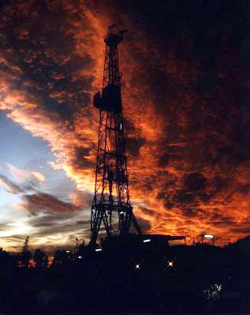
TYEE SPECIAL REPORT
[First in a three-part series on B.C.'s oil and gas future]
Alaska has it. Alberta has it. And, halfway around the world, Norway has it.
But here in British Columbia it's not even talked about.The "it" in question is a special fund in the billions of dollars, the interest from which goes to pay for public programs to the tune of hundreds of millions of dollars each year.The funds go by different names. To the north it's the Alaska Permanent Fund. To the east in Alberta it's the Heritage Fund. And, on the other side of the Atlantic, it's called the Norwegian Government Petroleum Fund.
In all three cases, big oil is behind the big funds. Not willingly, but as a result of conscious decisions by governments to hive off portions of the ballooning revenues generated by the exploitation of their oil and gas reserves and channel them into special funds that benefit local residents both today and tomorrow.
British Columbia has nowhere near the reserves of natural gas and oil that Alaska, Alberta or Norway has, but there are clearly a lot more revenues flowing from the province's northeast energy patch today than there were just five years ago. And if you go back 10 years, the increases are almost off the map.
Which has some wondering why the B.C. government isn't putting a sizable portion aside for a rainy day, or a future made $9 billion dollars more sustainable.
Ambitious plans for drilling
In 1993, energy revenues to the B.C. government, primarily from royalty fees, were $333.3 million dollars. By 1999 they were nearing $600 million. Last year, figures not yet published by the province's Ministry of Energy and Mines reveal that the province collected a record $2.03 billion in revenues.
The provincial government is determined to maintain that steep upward curve. As Premier Gordon Campbell told delegates to an oil and gas conference in Vancouver in December 2001: "We need to encourage oil and gas sector growth, and I want the industry to double the number of wells."
Campbell and provincial Energy and Mines Minister Richard Neufeld are also big fans of offshore oil and gas development.
Neufeld was recently part of a B.C. delegation of aboriginal, community and political leaders on a "fact finding mission" to Alabama where they were slated to visit a floating offshore oil rig in the Gulf of Mexico. Neufeld noted that the Gulf is notorious for hurricanes and rough weather, yet has a thriving offshore oil industry - a pointed reference to the Queen Charlotte Basin, where high winds and monster waves are
common and where some of B.C.'s richest oil and gas reserves are thought to be. Emphasis on thought because at this point all that Neufeld and others have is a "probabalistic assessment" of oil and gas potential published in 2001 by the Canadian Geological Survey. That paper pegs B.C.'s offshore reserves at 9.8 billion barrels of oil and 43.4 trillion cubic feet of gas.
If all of that was found and recovered (a virtual impossibility), B.C.'s offshore resources would be on par with what was originally thought to be in Prudhoe Bay in Alaska, and what gave rise to the creation of that state's Permanent Fund.
How big a windfall?
Alaska's Fund, now valued at US$28 billion, has been generated almost entirely on payments collected from oil producers and on subsequent investments by the Alaska Permanent Fund Corporation in real estate, stocks and bonds. (The state's gas reserves remain largely untapped due to the lack of a north-south pipeline.)Let's for argument's sake say that B.C.'s offshore reserves are developed beginning in 15 or so years, and that perhaps half of what is thought to be out there is actually recoverable. Let's also say that the amount of remaining natural gas thought to be in northeastern B.C. is recoverable. And while we're at it, let's throw into the mix coalbed methane, an untapped energy source that Neufeld, Campbell and others are pushing.
Would all of that energy be enough for a fund here in B.C.?
Dan Miller, the Minister of Energy, Mines and Petroleum Resources under the previous NDP government, says the answer in the late 1990s would have been no. Energy resources assumed growing importance under the NDP, whose attempts to encourage expansion included the "one-stop-shop" for oil and gas project approvals, B.C.'s Oil and Gas Commission. But revenues still were relatively small compared to today's, along with steeply escalating forecasts for both inland and offshore drilling.
Given the new equation, Miller told The Tyee, that thinking about a stand-alone fund now makes a lot more sense.Liberals have other priorities
The current Energy and Mines Minister, Neufeld, said a fund has its merits. But even in Alberta where the Heritage Fund was created in the 1970s and now sits at $12 billion in value, the provincial government long ago stopped transferring energy dollars to the fund, choosing instead to pay down government debt."We need to do those same kind of things. We have a huge debt left with us from the last administration," Neufeld told The Tyee. "The debt is $30 billion. Figure how long it's going to take to pay that off."
Neufeld added that with healthcare and education costs rising, it's almost certain that most of the money generated from oil production will go straight into paying for those two services. "We're going to take all [the natural gas and fossil fuel reserves] we can to provide the services that we have to to people in British Columbia - health care and education. [And] we want to look at retiring our debt over time."
After that, Neufeld said, the government might think about creating a stand-alone fund.
Opportunity measured in decades
But the window of opportunity won't remain open forever. The resources that would generate the money destined for a stand-alone fund continue to be developed. And they will eventually run out, never to be seen again for millions of years.
How much is there, and how long might it last? Less than 40 years by some expert estimates.
Carmine Vertone, supervisor of special projects with the Ministry of Energy and Mine's oil and gas division, says that to date approximately 25 trillion cubic feet of natural gas has been found in northeastern B.C. Sixteen trillion is now gone. Nine trillion remains. There is, however, at least an equal amount of gas likely to be recoverable, Vertone says. "If we look at geological studies done by the NEB (National Energy Board) and the Canadian Gas Potential Committee, they estimate that based on what we've discovered that there's another 26 trillion recoverable." Vertone adds that there is a "high degree" of certainty on that estimate.Last year, energy companies put approximately 900 million cubic feet of gas into the province's pipeline system, sending most of it south to U.S. customers. Based on similar rates of exploitation, that would deplete all known and believed to be recoverable reserves in the northeast in approximately 38 years.
A $9 billion B.C. savings account?
In Alaska, Alberta and Norway, all three governments looked ahead and decided that at least some money should be there for the day fossil fuels were depleted and that that money should come from today's exploitation of natural gas and oil reserves. If B.C. were to do what Alaska did in recent years and channel 25 per cent of the royalties and other monies it received from energy companies into a permanent fund of its own, how much money would be in such a fund if just the remaining fossil fuel reserves in the northeast are considered?
The answer could be $9 billion or more.
Here's how that number is arrived at by a conservative calculation. In the past 10 years, royalties and other energy sector payments to the provincial government averaged just under $890 million annually. Assume for now that the government put one quarter of $890 million per year into a permanent fund: In 38 years when the natural gas in B.C.'s Peace River country was gone, $8.44 billion would have been channeled into such a fund. And the fund would be worth several hundreds of millions if not a few billion more thanks to the interest earned on investments.
That scenario would certainly ring familiar to Alaskans. In their state in recent years one quarter to one half of big oil revenues to the State went into its Permanent Fund. As a result, this year, each qualified resident in the state received a dividend from the Permanent Fund. It came in the form of cheques, each one made out in the amount of $1,107.56. Even higher dividends have been paid in previous years from a fund that continues to grow in value, and that significantly no longer relies so much on transfers in oil revenues from the State as it does from investments the Permanent Fund Corporation makes in real estate, stocks and bonds.
The Fund's managers are already focussed on the day oil runs out. And one day down the road, even more so than today, Alaska's residents will be all the more grateful for it.
On Monday, Part 2: A Metis dispute with B.C. gas producers sharpens the question: Who benefits from the boom?
Freelance writer and researcher Ben Parfitt lives in Victoria. He is a frequent writer and commentator on natural resource, business, environmental and social justice issues for a variety of publications and author of Forest Follies: Adventures and Misadventures in the Great Canadian Forest. His previous article for The Tyee reported on legal aid cuts and women in abusive relationships. ![]()
















Tyee Commenting Guidelines
Comments that violate guidelines risk being deleted, and violations may result in a temporary or permanent user ban. Maintain the spirit of good conversation to stay in the discussion.
*Please note The Tyee is not a forum for spreading misinformation about COVID-19, denying its existence or minimizing its risk to public health.
Do:
Do not: